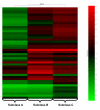Identification of pediatric septic shock subclasses based on genome-wide expression profiling
- PMID: 19624809
- PMCID: PMC2720987
- DOI: 10.1186/1741-7015-7-34
Identification of pediatric septic shock subclasses based on genome-wide expression profiling
Abstract
Background: Septic shock is a heterogeneous syndrome within which probably exist several biological subclasses. Discovery and identification of septic shock subclasses could provide the foundation for the design of more specifically targeted therapies. Herein we tested the hypothesis that pediatric septic shock subclasses can be discovered through genome-wide expression profiling.
Methods: Genome-wide expression profiling was conducted using whole blood-derived RNA from 98 children with septic shock, followed by a series of bioinformatic approaches targeted at subclass discovery and characterization.
Results: Three putative subclasses (subclasses A, B, and C) were initially identified based on an empiric, discovery-oriented expression filter and unsupervised hierarchical clustering. Statistical comparison of the three putative subclasses (analysis of variance, Bonferonni correction, P < 0.05) identified 6,934 differentially regulated genes. K-means clustering of these 6,934 genes generated 10 coordinately regulated gene clusters corresponding to multiple signaling and metabolic pathways, all of which were differentially regulated across the three subclasses. Leave one out cross-validation procedures indentified 100 genes having the strongest predictive values for subclass identification. Forty-four of these 100 genes corresponded to signaling pathways relevant to the adaptive immune system and glucocorticoid receptor signaling, the majority of which were repressed in subclass A patients. Subclass A patients were also characterized by repression of genes corresponding to zinc-related biology. Phenotypic analyses revealed that subclass A patients were younger, had a higher illness severity, and a higher mortality rate than patients in subclasses B and C.
Conclusion: Genome-wide expression profiling can identify pediatric septic shock subclasses having clinically relevant phenotypes.
Figures






References
-
- Marshall JC, Vincent JL, Fink MP, Cook DJ, Rubenfeld G, Foster D, Fisher CJ, Jr, Faist E, Reinhart K. Measures, markers, and mediators: toward a staging system for clinical sepsis. A report of the Fifth Toronto Sepsis Roundtable, Toronto, Ontario, Canada, October 25–26, 2000. Crit Care Med. 2003;31:1560–1567. doi: 10.1097/01.CCM.0000065186.67848.3A. - DOI - PubMed
-
- Jellema WT, Groeneveld AB, Wesseling KH, Thijs LG, Westerhof N, van Lieshout JJ. Heterogeneity and prediction of hemodynamic responses to dobutamine in patients with septic shock. Crit Care Med. 2006;34:2392–2398. doi: 10.1097/01.CCM.0000233871.52553.CD. - DOI - PubMed
-
- Reinhart K, Wiegand-Lohnert C, Grimminger F, Kaul M, Withington S, Treacher D, Eckart J, Willatts S, Bouza C, Krausch D, Stockenhuber F, Eiselstein J, Daum L, Kempeni J. Assessment of the safety and efficacy of the monoclonal anti-tumor necrosis factor antibody-fragment, MAK 195F, in patients with sepsis and septic shock: a multicenter, randomized, placebo-controlled, dose-ranging study. Crit Care Med. 1996;24:733–742. doi: 10.1097/00003246-199605000-00003. - DOI - PubMed
Publication types
MeSH terms
Substances
Grants and funding
LinkOut - more resources
Full Text Sources
Other Literature Sources
Molecular Biology Databases

